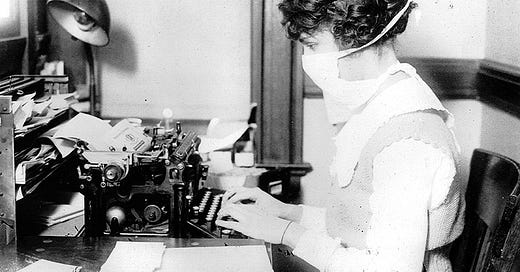In the autumn of 1918, as World War I drew to a close, a nasty strain of influenza swept across the globe; infected one-third of the world's population and claimed at least 50 million lives worldwide, including 675,000 Americans.
The pandemic's impact on American families and communities was profound. As one Red Cross report noted, "a fear and panic of the influenza, akin to the terror of the Middle Ages regarding the Black Plague,” was palpable through many parts of the country. In some cases, entire towns were left without caregivers, doctors, or funeral staff.
The Response
The United States' response to the 1918 influenza pandemic was marked by a lack of coordination. With no centralized federal strategy, states and cities implemented their own measures. A now famous study analyzed these community measures, and their affect on mortality rates. St. Louis, enacted early and aggressive interventions, including school closures and bans on public gatherings, resulting in lower mortality rates. Others, such as Philadelphia, delayed action, and even allowed a public parade to take place, leading to devastating consequences.
Such outcomes highlighted the need for a cohesive national approach to public health crises. Decades later, this understanding informed the development of a federal pandemic preparedness plan, commissioned by the Bush administration. This playbook used lessons from the aforementioned study of community responses during the 1918 pandemic.
Ironically, the playbook was thrown out by U.S. officials before the COVID pandemic, but was utilized by other countries, saving countless lives.
More Trauma
But immediately after 1919, there were no sweeping health reforms. President Warren G. Harding swept into office in 1920, promising “a return to normalcy” after WWI and the pandemic. His administration prioritized business interests, deregulation, and tax cuts. The U.S. withdrew from international engagement (rejecting the League of Nations) and focused inward, emphasizing economic growth, consumerism, and technological advancement.
The investments in business neglected the combined mortality shock of WWI and the flu (much of which concentrated in working-age people), and the resulting weakness in labor and demand. The failures during the '20’s to protect working Americans furthered structural weaknesses in the economy; weaknesses which led to speculative investments, bank runs, mass lay-offs, and a trade-war started by tariffs…
What followed is known as the Great Depression. The stock market lost almost 90% of its value. The average family income fell by 40%. Around 300,000 businesses went belly-up. And, huge swaths of people moved out west, desperate for a better future.
The New Era
By 1932, the failures of the old-guard were unmistakable. Franklin D. Roosevelt won a landslide victory, campaigning not just on restoring the economy, but on rebuilding the capacity of the federal government to stabilize markets, to insure against risk, and to protect the vulnerable. The Social Security Act, the growth of the Public Health Service, the Federal Emergency Response Act (FERA), Federal Deposit Insurance (FDIC), Fair Labor and Standards Act (FLSA set a minimum wage and 40-hour workweek), and the National Highway system epitomized policies meant to benefit and protect the working-class.
The Cold War affirmed this new-guard. State capacity was no longer just a domestic necessity; it became a matter of geopolitical importance. Federal investments in science, infrastructure, and healthcare were justified as tools to compete with the Soviet Union. Programs like Medicare and Medicaid were not isolated acts of charity, but part of a broader political economy that saw a healthy, secure population as a national asset.
The era that followed was marked by individualism, deregulation, globalization, and growth.
Does This Sound Familiar?
A century after the Spanish Flu, the COVID-19 pandemic has proven to be another political reckoning. Like its 1918 predecessor, COVID-19 exposed the limits of America’s approach to public health. Testing delays, hospital overcrowding, and supply chain failures underscored systemic weaknesses of a fragmented healthcare system.
I feel it’s necessary to say here: I’ll continue to write mostly from the lens of healthcare, but the modern American affordability crisis runs deep.
What’s emerging now is not a return to the New Deal model; it’s something messier. The world today is much faster, more complex, and more interconnected than systems in the past. Yet, the convergence of grassroots forces in healthcare, energy, and housing; issues circling federal responsibility and economic inequality; major shifts in geopolitics and trade, all necessitate a very serious reading of this period in our history.
History Might Rhyme
We may be in the beginnings of a seismic shift in American politics. The Spanish Flu and the Great Depression remind us that the readiness for political change is both economic, and psychological. It’s about what people come to expect from their government, and what they believe they have the right to demand. If we fail to understand how trauma, crisis, and policy interact, we risk missing the moment for real transformation.



